Los Angeles is developing and integrating web3 tools as a means of establishing ‘democratic’ methods of online consuming, while Silicon Valley…What is going on in Silicon Valley? If Sweden exports cultural styles and trends to Western European countries, and Western European countries export cultural leftovers to Eastern European countries so that they can make faux versions of them, could the same be said about the leading trends of the internet? Silicon Valley sends trends, ideas, and visions of the internet —> to be executed in Los Angeles —> to be inherited by Amsterdam —> to be maintained by Bosnia who joined the scene a bit late but since software development is still very needed, somebody’s gotta do it.
Of all the professional plans that I had for this summer, learning React.js failed me. My endeavor, rushed by my cousin who is becoming a web, probably software developer so quickly that his knowledge awoke my tech imposter, detoured when two kind developers in Los Angeles advised me to learn Vue.js instead. According to them, it is a lighter framework that only requires one line of code in order to be installed. Their opinion made me hopeful about their eco-consciousness in the realm of the web. But enough about learning the tech. Something else was more urgent than the plans I had for my performance in front of the screen: driving up towards the Bay Area to find out what’s going on in Silicon Valley and, naively, search for traces of ‘feminist’ / female web design.
My first stop was in Santa Cruz. I booked a king studio for two nights in a motel that seemed to offer a decent setup for a female freelance web developer with a head full of questions. It resembled my living setup in the last five years since I became one. Wide, rectangular, see-through. Living and working zones merged without any walls or curtains dividing them. Always convenient for work. After parking in the motel’s parking lot, I started walking towards a space that looked like a reception from far away. From where I was standing, it looked empty. But since all the other doors looked like they were leading to motel rooms, I had no choice but to find out if that was where I had to check-in.
I didn’t even get two steps away from the window that looked like a check-in desk when a machine with a screen in front of it went on and started talking to me. I kept looking inside the reception space to locate the source of the voice, but as I walked closer, I noticed a human inside of the machine’s screen looking at me. “Where are you?” – I asked him as soon as I was close enough, as if not believing that he was real and not pre-programmed.
He smiled in response, as if not used to being asked this question. “I’m working remotely today” – he said, after which I greeted him. He was wearing a formal suit and seemed to be in a different timezone (some +12,5 hours). His background was blurry and the lights on his face were whiteish, the office-y ones that most people dislike. He’ll probably work remotely tomorrow too. – I thought to myself.
He was a human in the body of the kindest bot. He didn’t repeat himself. He instructed me where to place my driver’s ID for identity verification, which helped me feel less awkward about interacting with the machine. While he was preparing my contract, I looked inside the reception area and it looked completely unattended. It looked like no human was there for a long time.
When everything was confirmed, he told me the number of my studio and pushed a room card through the machine for me. I didn’t ask how he did that, thinking that my first question was enough. I also didn’t get a chance to tell him how excited I am to come to the Bay Area and look for traces of feminist web design. I also didn’t get a chance to tell him that he, and the machine, are a part of something important to me — be it my hope or hopelessness.
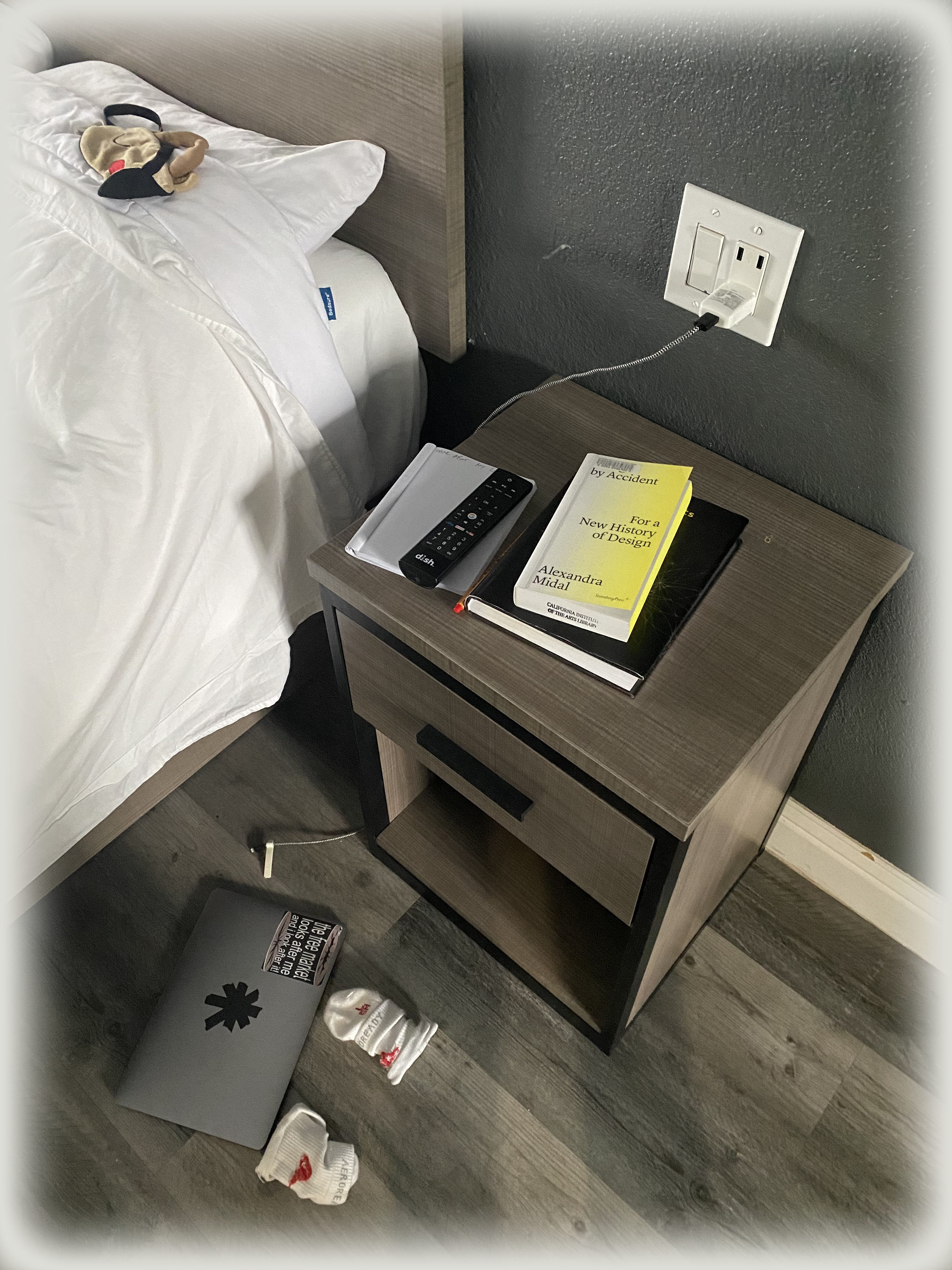
***
The Silicon Valley Self-Guided Driving Audio Tour for Technology Lovers cost me $24,99. In order to access it, I had to download an app (Action Tour Guide) that had adequate tools to host it. The interface of the app is pretty simple, blue like Facebook, a bit darker. It has two tabs on the dashboard. The right one leads to the My Tours page and the left one leads to the Explore area which is some sort of a bazaar listing tour guides available for direct purchase. Most of them are developed for America, but there are a few international ones.
My purchased tour had a Start button next to its name. Clicking it opens a Map with pinned numbers that show the route I was about to take. These numbers represented what the app calls stories. There are 66 stories included in this trip, but not all of them mean that they’re stop points. When you reach the story spot, the app will match your geolocation to the designated area which plays the story assigned to it.
The tour started at Menlo Park, Facebook’s headquarters. The semi-robotic male voice welcomed me and gave a brief summary of how it works, as well as full freedom to take more time than 3 hours to complete the tour should I feel the need to stick around some spots longer than the app predicted. I nodded to him in a random direction, internally communicating that I surely will. I wasn’t pretending to be a nerdy web developer for whom this tour is a dream come true (for different reasons). Menlo Park was our meeting point, a place where we’d get to learn that, compared to my virtual assistant from the day before, this one was pre-programmed. For easier communication, I will call him Senad (not a coincidence).
Our next stop was Meta slash WhatsApp slash Instagram. As I drove around the sprawling campus, Senad started excitingly diving into the past of what seemed to him like a kingdom. He told me that it all started from Mark Zuckerberg’s desire to give his fellow classmates an opportunity to judge photos of their female classmates to decide who was hotter. I was surprised to learn about this at the beginning of the tour and immediately assumed that the fellow students Mark had in mind were obviously not the females he chose to be subjects of his app. The app (FaceMash) immediately gained attraction, causing Harvard to almost expel Mark for privacy violation. (Yes, he was a Harvard boy, not a self-taught programmer coming out of his garage with a product resulting from three months of isolation and social starvation.) One year later, FaceMash became The Face Book, where Harvard women were finally given access to rate Harvard men’s and each other’s faces. By 2006, the platform became accessible to all kinds of faces, including those from the University of Life.
As I drove some more, Senad was telling me that Silicon Valley’s workplaces are kinda wacky, Meta being the leader of the style. Designed by Frank Gehry as a miniature village of sorts, it’s supposed to inspire its employees to take a breath of fresh air and stroll along the rooftop walkways. In other words, not come out of the building. I was kinda fascinated by the varied architecture of what looked like a stolen + relocated village of sorts, but it did not give any cultural vibes like a squatting place would. The design works really well: no soul was walking outside apart from me and the traffic guides.
“Likewise, one hears stories about computers being ‘possibility’ machines: they operate not through vague estimations of practice, but through hard, mechanic possibilities of truth or falsehood, openness or closeness, on or off. So I suggest that these terms ‘definition’ and ‘possibility’ might do more harm than good if our aim is to understand the machine and how it works.” – Alexander Galloway, The Interface Effect
Immediately after I hit the road, Senad brought it up, he asked if technology is good or bad. He framed it as the second biggest debate in tech and went on to explain both perspectives. When he started explaining why it’s good, he didn’t say “Technology” but “Facebook”. Facebook is good because it connects friends and families across time + space like never before. One could easily stay in touch after graduation and share photos with others. To give a contemporary example, we find it useful atm to stay informed about the violence happening in Gaza, by following young journalists who are directly posting in their feed, instead of stories which have already overwhelmed us. Given the examples, why would one not think that technology is good? In Senad’s words, “Didn’t that make it a force for good?”
Changing his tone from sweet to critical, he went on to introduce the dark side of Facebook. He told me that, as it grew, it became a propaganda tool for politics, a shelter for false facts, and a game changer for personal privacy because everyone became searchable. To give a contemporary example, we are trackable when making an appearance at the solidarity protests for Palestinians. “So is Facebook bad?” – he asked, not as persuasively as whether it’s good. I have to admit, I was naively gonna choose a side, but Senad pulled me out by saying that what we were going to learn later on is that it’s not technology that is good or bad, but what we choose to do with it. We are good or bad and he was good at distracting my thoughts by pulling me in the midst of binary thinking. One thing he couldn’t get out of my head was wondering why he abruptly replaced the word Technology with Facebook.
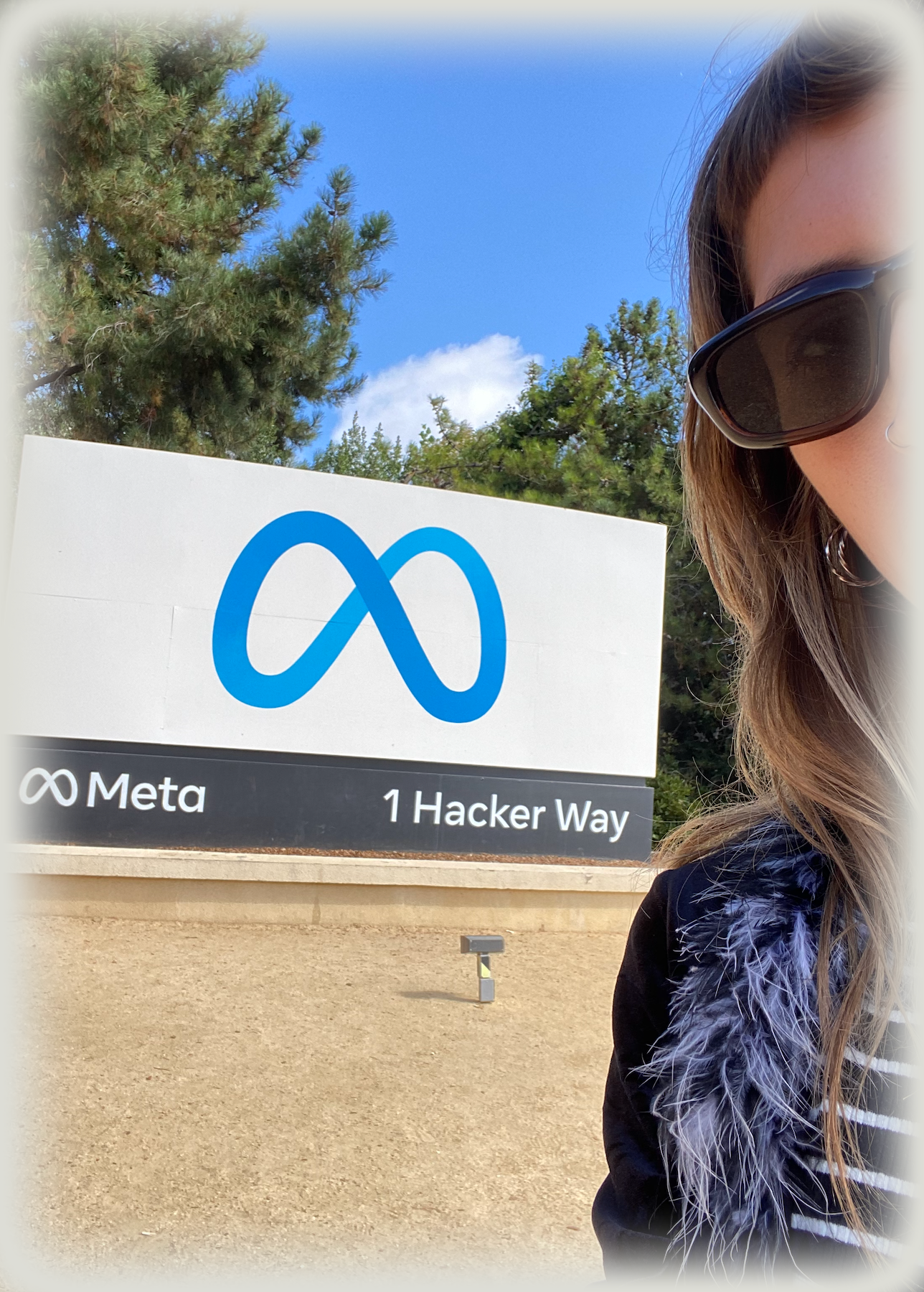
Senad and I continued driving to the Amazon building, but not its headquarters (maybe one day in Seattle). Oh Amazon, the beating heart of e-commerce. I can’t say anything about you from this spot where I parked and around which you seem to be operating, doing the things that you do. There are no people running around you, or rushing through you to emphasize your importance. You look so plain, you could be a hospital. Just when I started wondering why I came here, Senad whispered to my ears the brief history of the company’s magic aka how Bezos, its founder, got so rich. Back in the day, he was manually shipping books to customers. This laborious activity led him to exhaustion but also an amazing idea to pre-order books from mass distributors. The problem he ran into was that book distributors only shipped books in batches of 10 or more, which Bezos couldn’t afford. So he ordered one book he actually wanted +9 that were always out-of-stock. The distributors charged and shipped only one book. After that, AMAZON, an online bookstore. Three years later: beyond a bookstore, and even a cloud server you could own.
I was confused by the novelty of Bezos’ idea that was sparked by what seemed an uncomfortable online shopping experience. Although Senad deeply believed in it, I thought the guy simply didn’t want to miss out on a chance to make the $150 billion that he’s worth today. To help me understand the amount, Senad broke it down to small political investments. He told me that it’d cost $25 billion to end hunger in America, another $20 (billion) to end homelessness, and the rest for doubling the funding for cancer research, revolutionizing American transit, and donating 10 million Pell Grants to low-income students. Basically, it’d solve a lot of the problems that make the American dream less American. Even if these investments were made, Bezos would have money left over to enjoy a better version of America.
Replacing Technology with Amazon now, Senad asked me if it’s good or bad. Is having a tough time resisting the lure of online convenience good or bad? At this point, I wished that Senad was present in real-time, either virtually or physically, so that I could ask him why he thinks that shopping is all there is to human existence, why technology that is not a social media platform doesn’t count as technology, why driving around the headquarters does not give me the sense of space that he promised at the beginning of the tour, and something like why the sky is blue…My interest in exploring Silicon Valley architecture started to fade along with the stories that came with it. But Senad kept ranting.
“While Amazon’s changed everything about shopping, Google has changed everything, period.” He asked me to imagine a world in which there is no Google (but gives me zero time to actually imagine that world.) He started teasing me by questioning if I knew my way around town now that Google Maps is gone (in this new, imagined world). But are the streets gone? My e-mails are gone! But are the people whom I send them to? My Google Docs, Sheets, Slides, Hangouts, YouTube, and all the products are gone! But are my writing, counting, talking, and listening skills gone too?
While fighting with Senad in my head, I found myself driving through the enormous Googleplex campus. I parked and got out of the car to get some fresh air. As I strolled between the buildings, I discovered a 25th anniversary party. People wearing birthday hats were talking about strategies, a lot of which I chose not to listen to. I felt lucky. On my way back to the car, I took a selfie in front of one Google sign for this article. I caught some people looking at me and probably joking about it. They must have been employees, the Googlers or the Nooglers.
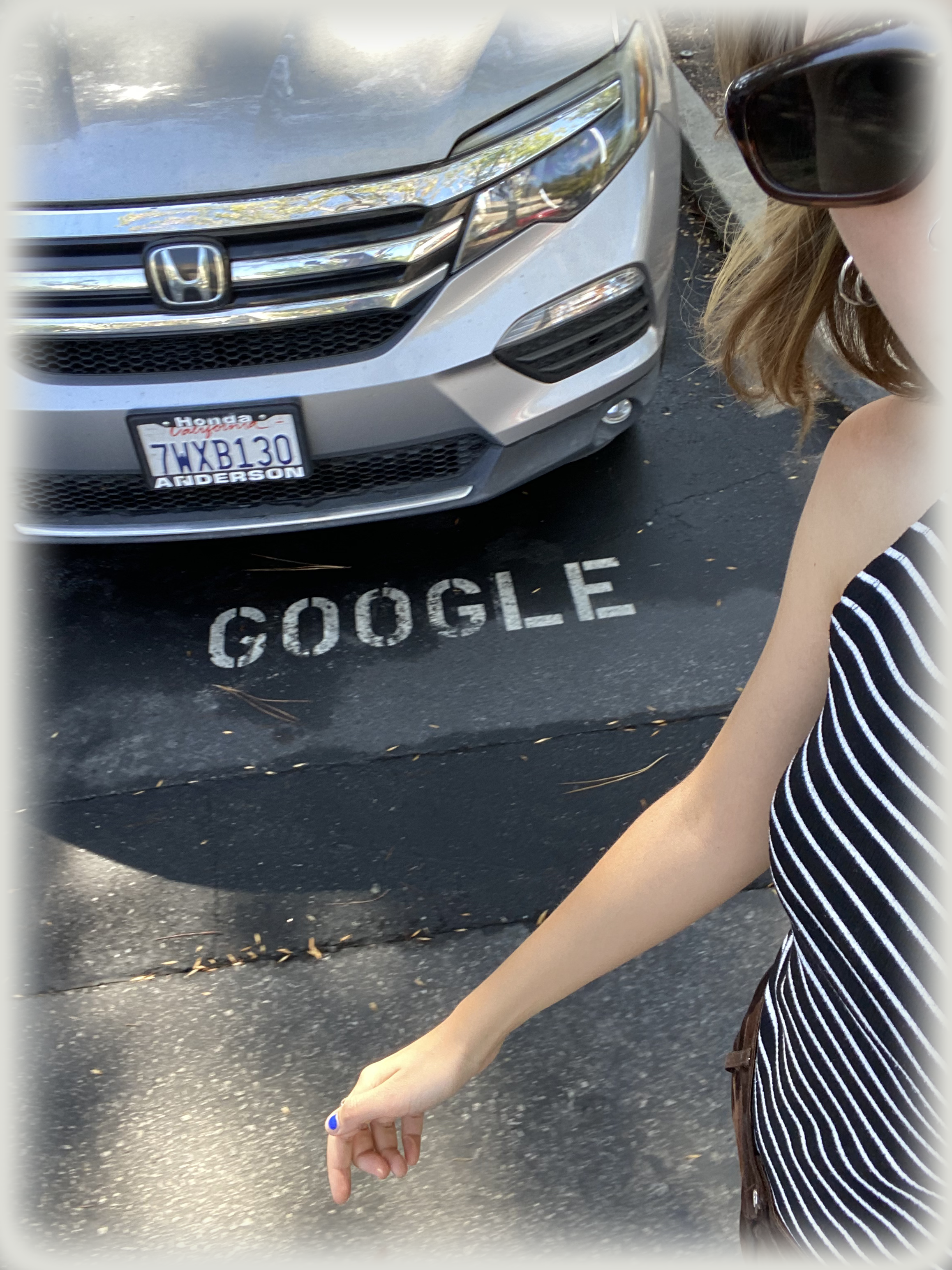
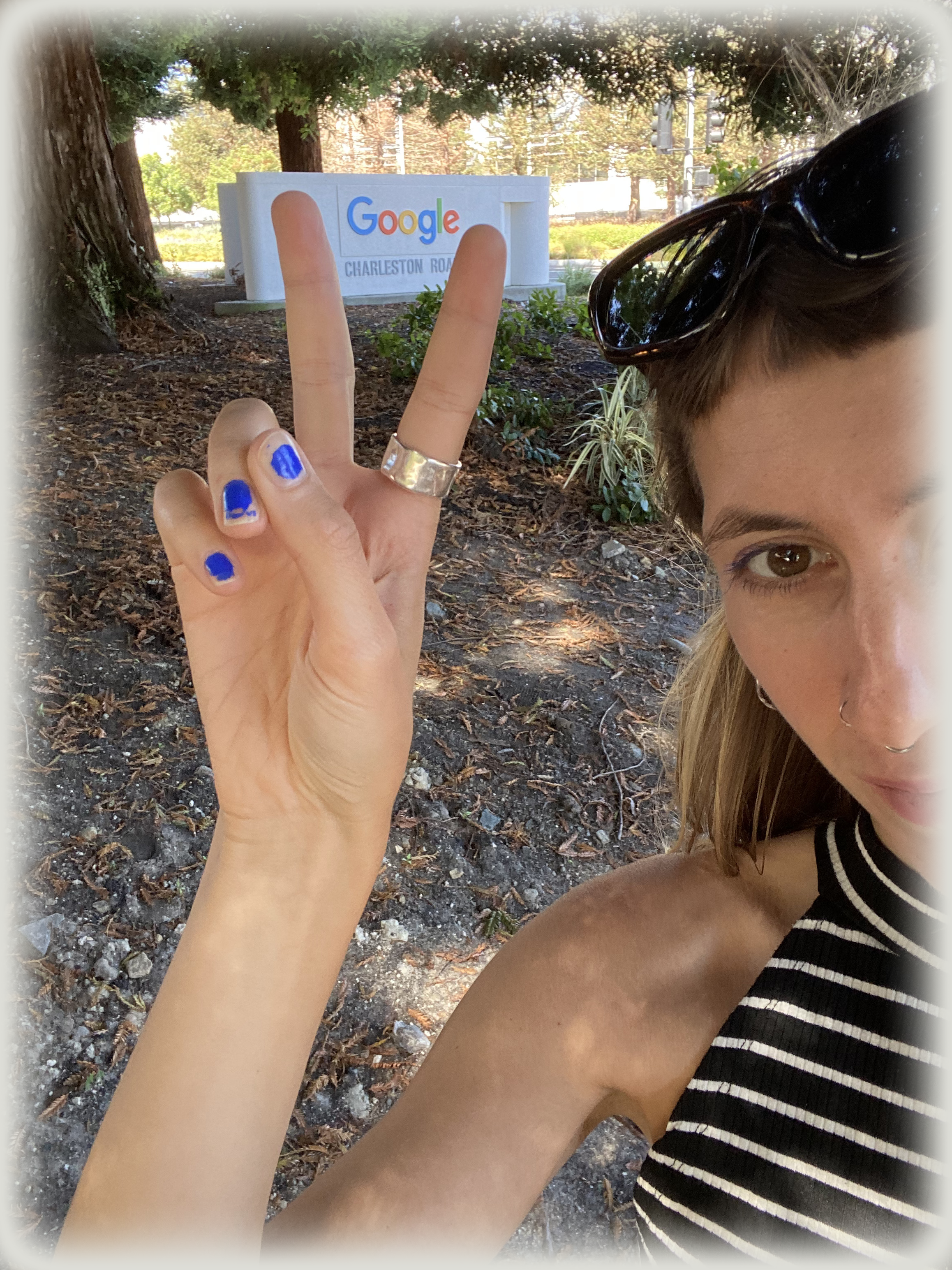
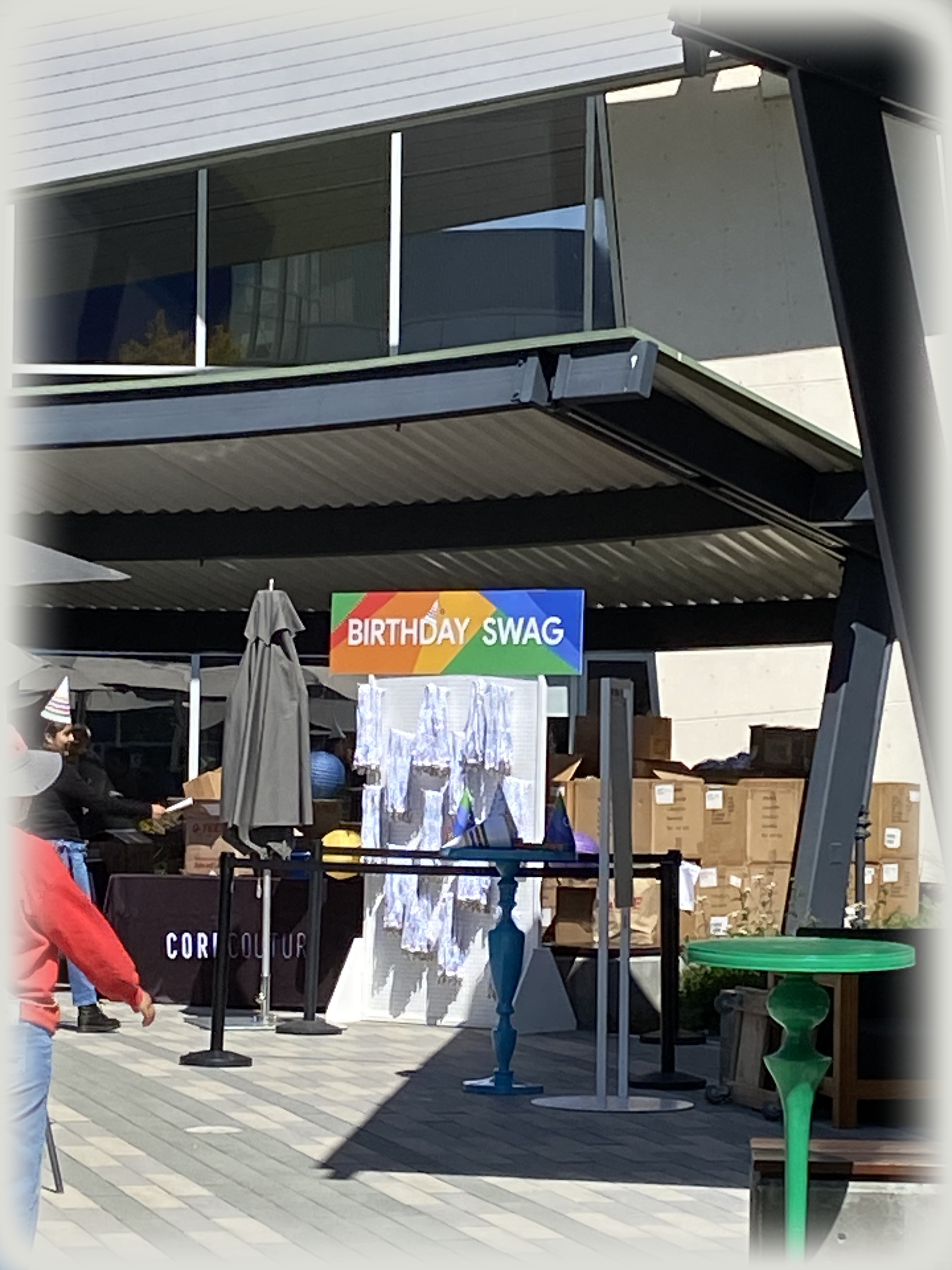
Senad took me to a spot marked as a Must-See on the app: Microsoft. He explained that it’s technically not a Silicon Valley-founded company but that it’s impossible to talk about tech without it. It literally built the looks and functions of today’s computers and is to blame (or praise?) for everyone having a computer in every home. Before Bill Gates joined the parlor, every computer had its own custom software, so software was way more diverse. Senad presented this as annoying for everyone, especially program creators who wanted to make their software work on all computers slash universal. Bill Gates came in and made a universal translator for all different systems and called it, “dun dun dun”, Windows! It was the origin of Start buttons, taskbars, and solitaire.
Long story short, Microsoft made it possible for all the previously visited tech giants to become giant even though the building looked like the black swan of Silicon Valley. It didn’t seem innovative or wacky enough, just classic and somewhat unwelcoming. The parking lot was smaller and had employees-only signs everywhere.
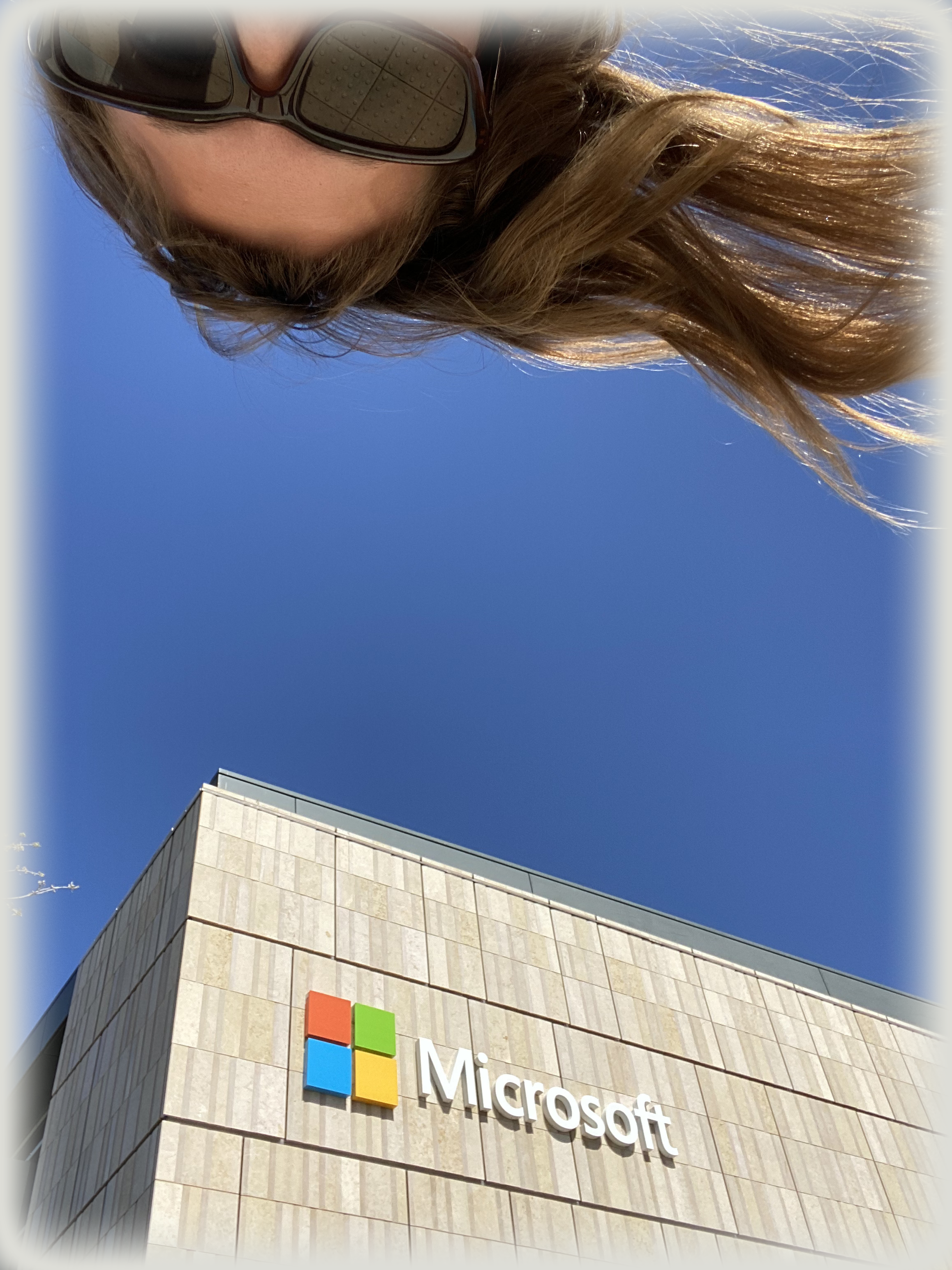
I knew that the next stop would be Apple’s Infinity Loop, the company that aimed to make better computers. While an improvement always refers to the source it’s trying to get better than, the exception is to be found in the debate about Apple and Windows. While Windows was thriving for function, Apple was obsessed with design. The two differing philosophies gained separate popularities and now we have two kinds of people in consumer society. I had low hopes that Senad would bring up Susan Kare, a designer who designed some of the graphics for Macintosh. Her joyful icon and symbol designs helped people learn to navigate an unfamiliar technology. They were user-friendly and appealed to non-technical users. They’re familiar to all of us today. I’m not mentioning her work with an intention to fill in the female gap in the history of tech, but because I can’t think about Apple without her contribution to its design vision.
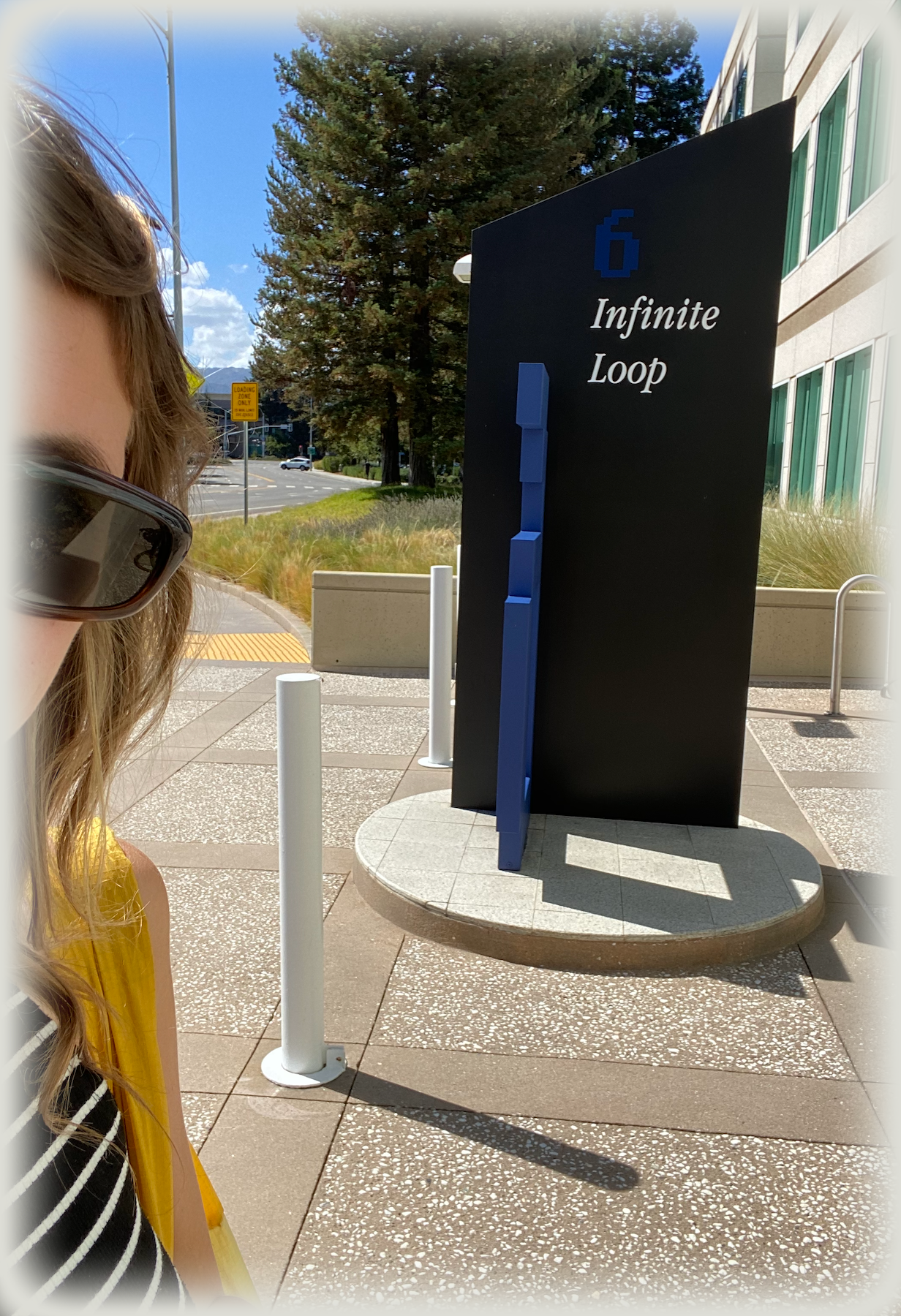
While I was walking around the loop, I did the cliche thing of eating an apple and wondered how many people did the same. I also tried to pass the entrance gate with my Female Freelance Web Developer status, but was directed to check out iPhone 15 in the Apple Store.r garages had a view of their dads’ swimming pools.
Before my last stop, I went to Tesla, just to take this pic.
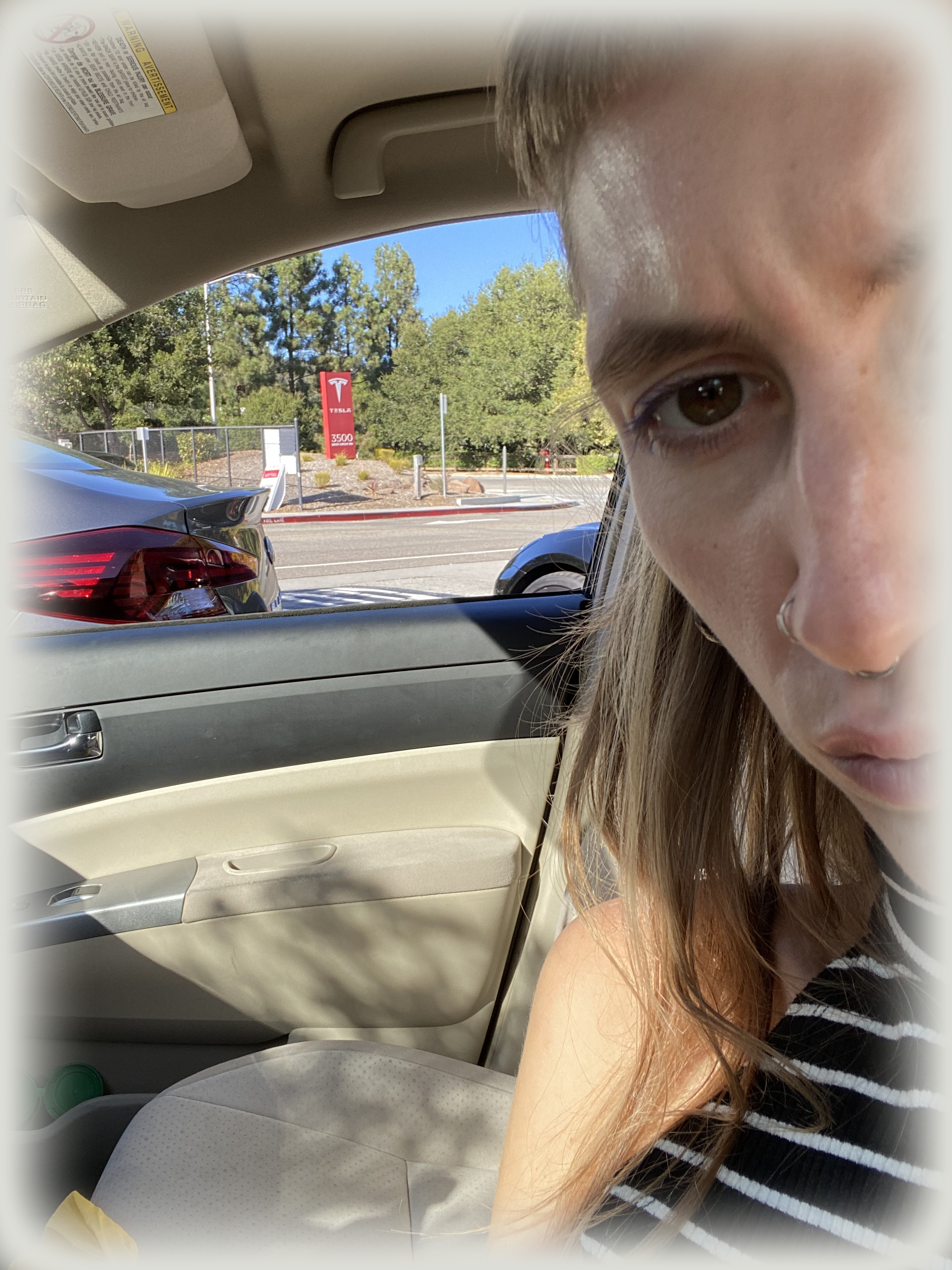
Before heading back to Santa Cruz to prepare for an interview with Warren Sack the next day, I drove through the Stanford campus. The sun was setting, athletes were running. The landscapes around were insanely beautiful and the ground felt really rich. The concrete floor was clean. The permit-only signs on every parking lot allowed me to get out of the car for only a few minutes. I walked to the athletics field and watched the runners loop their performances. I felt tiny like a tiny tech.
***
When I got back to LA, I called my dad to share my thoughts about the perks of being Senad and my impressions of Silicon Valley. I told him how I never learned so many facts about the tech giants in one day, and that people in Bosnia should stop thinking of them as programming talents who came out of their nasty garages. The truth is that all of them got privately trained to become programmers from a very young age and that they tested their ideas on campuses similar to the one where my tour ended. They built apps for connecting families but never had a chance to experience what the feeling of missing felt like (like the one I had while talking to my dad who is in Croatia). + Their garages had a view of their dads’ swimming pools.
In Bosnia & Herzegovina, software development is a hit right now. The giant founders of the giant tech companies in Silicon Valley are perceived as the heroes of economy and social life. While the dark truth is known amongst older generations, the young programmers, who will soon define the Bosnian tech scene, still look up to these characters when seeking inspiration and defining their goals. My little cousin who, I’m sure, will soon be in the scene’s front row, tried to win a self-made battle with me. Whoever codes with more tools + technologies would be the winner. I assured him right away that he does and moved on to explain how he can integrate interactive 3D objects on a website in a much simpler way than he was planning to. I stopped replying to his messages when I realized that he wasn’t looking for a simpler way to code.
